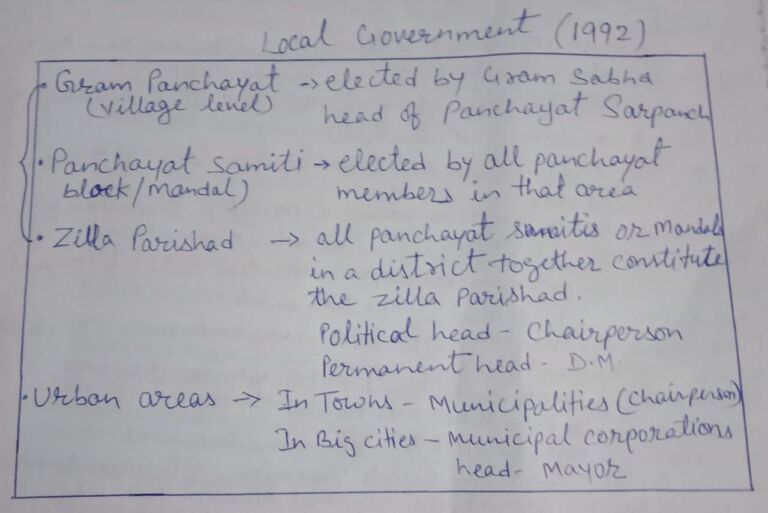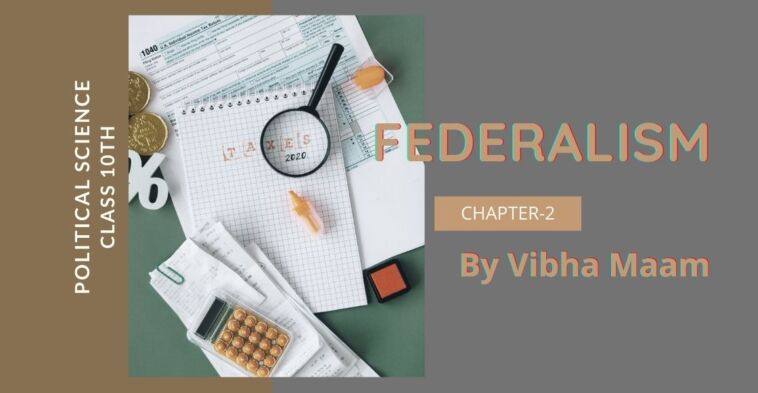Checkout handpicked notes of NCERT class 10th Pol Science Chapter 2 Federalism notes by Vibha Madam, and don’t forget to share your valuable comments in the comment below to motivate our author.
Federalism Notes by Vibha Maam
What is federalism?
Federalism is a system of government in which the power is divided between the union and the provinces. Usually it has two levels of government.
Federal Government
- Power is divided between the Central authority and various constituent units of the country.
- Different levels enjoy power independently.
Unitary Government
- One level of government
- No division of powers
- Subunits are subordinate to central government
Features of Federalism
- Two or more levels of government
- Each tier has its own jurisdiction in specific matters of legislation, taxation, etc.
- Existence and authority of each tier is constitutionally guaranteed
- Changes by consent of both the levels of government
- Independent judiciary
- Financial autonomy
- Dual objectives
Two routes of federation
Coming together federation and holding together federation
Coming together federation – States come together to form bigger units like USA, Switzerland, Australia
Holding together federation – Large country divides its power between the constituent units like India, Spain, Belgium
Features of Indian federation
Three list system – Union list (defence, foreign affairs, banking, currency)
State list (police, trade, commerce ,agriculture) and
Concurrent list (education, forest, marriage)
Residuary list (computer software)
- Independent judiciary
- Two third majority needed to amend constitution in parliament
- Three tier of federalism added in the form of Panchayats and municipalities
- Central government has special power in union territories

Federalism practised in India
- Linguistic States – Based on cultural, ethnicity or geography
- Language policy – No national language, 22 •scheduled languages, Hindi and English official languages
- Central state relation – Rise of regional parties, coalition government at Centre
- Decentralization – Decentralise power to the level of villages and towns.
Decentralisation in India
Constitutional Amendment Act 1992
Local self government on
Rural level :- Panchayats
Urban level :- Municipal corporation and committees.
Constitution amended to make the third- tier of democracy more powerful and effective by
- Mandatory regular election
- State election commission
- Seats reserved for women’s and SCs / STs
- Share of revenue with local governments.
Don’t forget to comment in the comment section below to appreciate and motivate our author by sharing this notes with your friends you can also Contact us for any query or if you are interested in writing with us.
Use Canva for amazing images.
Stay tuned for more amazing stories, poems & articles like this.
For sponsor any article or your article you can mail us with your logo ready and details.











Thank you mam for these notes
Thanks mam for notes!
Thank you mam for these amazing notes😄😄
Fantastic notes
Fantastic notes mam
Appreciable for your hard work. Thank you mam for providing these notes!
fabulous notes ji mam ji
appreciable efforts maam
awesome notes mam
thank you mam you sent these notes
Thank you ma’am
awesome notes mam
Mam thank you so much for providing these notes….. It helps alot in exams and i easily get everything… It’s such a nice way, thanks a lot mam once again.
👍💯